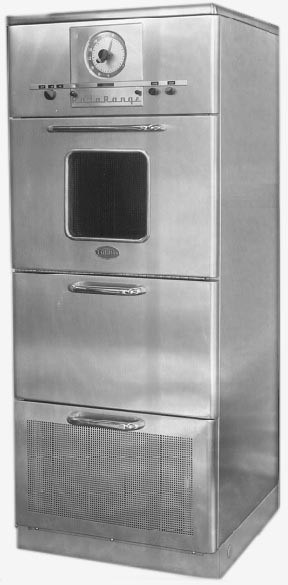
In 1942, while Dr.Percy Spencer was testing a magnetron, a candy bar in his pocket melted. This was Dr. Spencer’s ‘aha moment’ when he realized that radioactive beams can cook food. The Raytheon Company filed a patent application for Spencer’s invention on October 8, 1945. Then the company built the first commercially available microwave oven calling it the Radarange. It debuted in 1947 standing six feet tall and weighing over 700 pounds.1
Obviously, this behemoth model did not become popular in the average American home. However, during the 1970s, smaller “electronic ovens” started to make their way into the ordinary kitchen. At first, they were used reticently because the radioactive waves were considered harmful. However, the convenience of microwave cooking outweighed the fear factor. During the 1980s, the market was saturated with microwave cookbooks and products such as microwave bacon trays. Even Dire Straits references the kitchen appliance in Money for Nothing. Today’s average microwave cooks between 1000-1200 watts and is America’s sweetheart appliance for fast and convenient defrosting of frozen foods, rewarming of leftovers, or popping of corn. Bon appétit!
How does a microwave oven work? “A microwave oven produces high-frequency electromagnetic waves. Passing through food, the waves reverse polarity billions of times a second. The food’s water molecules also have polarity, and they react to each change by rapidly reversing themselves. Friction results, heating the water and cooking the food.2 For a visual explanation, watch the video, “How a Microwave Oven Works” by Bill Hammack from the Department of Chemical & Biomolecular Engineering, University of Illinois at Urbana-Champaign.
References

1 National Microwave Day (December 6, 2009)
2 Langone, John. How Things Work: Everyday Technology Explained. Washington D.C.: National Geographic Society, 2006, p.14. Engineering Library T47 .L2923 2006
3 Spencer, Percy L. Method of treating foodstuffs. U.S. Patent 2,495,429, filed October 8, 1945, issued January 24, 1950. Source: Google Patents
Books and Standards
Crupi, Giovanni, Editor. Microwave De-Embedding: From Theory to Applications. Waltham, MA: Elsevier/Academic Press, 2014. Engineering Library TK7876 .M53 2014
Hwang, Ruey-Bing. Periodic Structures: Mode-Matching Approach and Applications in Electromagnetic Engineering. Singapore: Wiley, 2013. Engineering Library TK872.F5 H93 2013
Maas, Stephen A. Practical Microwave Circuits. Boston: Artech House, 2014. Engineering Library (on order)
Pozar, David M. Microwave Engineering, 3rd. Hoboken, NJ: J. Wiley, 2005. Engineering Library TK7876 .P69 2005
Rohde, Ulrich L. RF/Microwave Circuit Design for Wireless Applications, 2nd. Hoboken, NJ: Wiley, 2013. Engineering Library TK7876 .R65 2013
Subcommittee F02.15 on Chemical/Safety Products microwave oven standards (Source: ASTM)